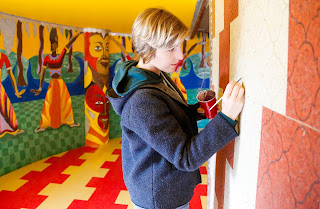Christmas 1900
Christmas 1899 must have been an enjoyable occasion because the family spent Christmas 1900 at Staatsburgh as well. Many wealthy families like the Millses left the city to spend the holiday in a quiet, country location. Nearby Tuxedo Park was also a popular location for many families. |
| Wilbur and Orville Wright's Christmas Tree, 1900 |
Marking the beginning of a new century, 1900 brought a seven-month-long world's fair in Paris. The 1900 Paris Exposition Universelle celebrated the achievements of the last century and the new developments moving the world forward in the next. Over 50 million people from around the world visited the fair. It was an election year in the United States and President William McKinley was re-elected. He defeated William Jennings Bryan just as he had in 1896, but this time his running mate was none other than New York governor and rising star, Theodore Roosevelt. The Poughkeepsie Eagle's Christmas day edition makes little mention of Christmas since the holiday had not yet become a mass marketing scheme. For the Mills family, the holiday was a quiet family affair at their country home.












